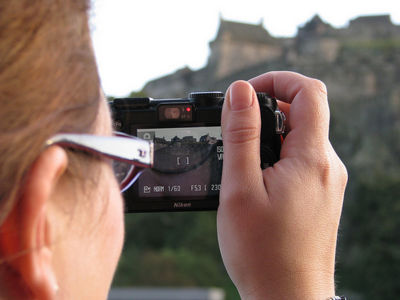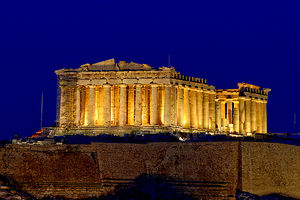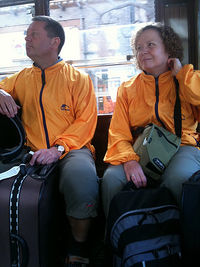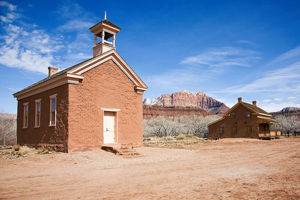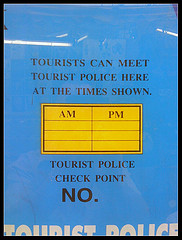Day in the life of a tourist
Day in the life of a tourist
The World Tourism Organization defines tourists as people who "travel to and stay in places outside their usual environment for more than twenty-four (24) hours and not more than one consecutive year for leisure, business and other purposes not related to the exercise of an activity remunerated from within the place visited". Wikipedia.org
This is the first of four courses which form "Introduction to Tourism" a course contained within the Certificate in Applied Travel and Tourism programme. Once all four courses have been completed those enrolled will have gained the New Zealand National Certificate in Tourism (Core Skills) Level 3 and will then go onto complete the full 12 month programme.
Learning Objectives
1. Unit Standards linked to this course: US 23758, US 23761, US 23766, US 23768, US 18212, US 18226
Scenario
James Stewart, a British restaurant owner has decided to attend the New Zealand Wine Institute Conference in Napier. His wife, Shanti, (travelling on an Indian passport) will be accompanying him. After the conference, their son Scott, who is an Australian citizen, will join them for a two week holiday travelling around the North and South Islands of New Zealand.
What is Tourism?
How do we define it? It is often described as the activity of people travelling on holiday but tourism is a lot more than this concept. It is very difficult to find a set definition but the following was devised by the World Tourism Organisation (WTO):
Tourism comprises of the activities of people travelling to and staying in places outside their usual environment for more than twenty-four (24) hours and not more than one consecutive year for leisure, business and other purposes not related to the exercise of an activity remunerated from within the place visited.
As you can see, tourism involves travel as the tourist has to move from their normal place of residence and also there are time limits of more than 24 hours and less than one year. However, this is not the total extent of the impact of the tourism. It also refers to the development of an industry to cater to the needs of tourists and the impact of the industry and the tourists on the host community.
Tourism is not a new phenomena and has been traced back to the Babylonian and Egyptian empires (approx three millennia BC). People travelled for trading purposes, matters of state government and for military purposes. There is also evidence of religious pilgrimages. What do you think was the main type of transportation at this time? The first Olympic Games were held in Greece in 776BC and were so important that the wars were stopped and roads were toll free during the event. Early tourists also liked to leave evidence that they had visited a destination and graffiti has been discovered in Egypt dating back to 2000BC.
The wealthy citizens also travelled to see major sites such as the Parthenon and artworks and to experience different cultures. There were passport like documents as far back as 1500BC and there are biblical references to "letters" allowing passage for travellers. Spa and health tourism was first instigated by the Romans.
We will look at a snapshot of "Tourism through the Ages". History of tourism
Some definitions of tourism also include the activities undertaken during the tourists stay at their destination and the facilities created to cater to their needs. In groups, create a mindmap with the word TOURISM at the centre and link as many products, ideas, pictures, words that you associate with the tourism industry.
What is a Tourist?
We have had a look at the definition for tourism so the tourist is the person who travels within that definition e.g. someone who leaves their normal place of residence and work for leisure, business and other purposes that do not relate to an activity remunerated from within the place visited. Within this definition there are further terms relating to different types to tourists. The first activity asks you to define some of the terms commonly used in tourism statistics and publications.
Tourists are also categorised dependant on their style of travel. The following are some of the classifications used in the New Zealand tourism industry.
FIT - Free Independent Traveller - Visitors who travel independently (but can be with friends or family)as opposed to a coach or packaged tour. They will only have purchased their international airfare prior to arriving in New Zealand so any other travel arrangements e.g. accommodation, tours, meals, domestic air fares, attractions and conference fees will be paid for during their stay.
SIT - Semi Independent Traveller - Similar to a FIT but will have purchased their international airfare to New Zealand as well as one other tourism product e.g. accommodation, tour, domestic air fare and/or conference fees.
Backpacker - These travellers are also similar to a SIT, as some or all of their arrangements can be paid prior to arrival in New Zealand. They are generally young and to be included in this category must stay in a backpacker style of accommodation.
Package Traveller - Someone who has purchased their international airfares, accommodation and at least two other items prior to arrival in New Zealand. They can be travelling alone or with friends/family but are not part of a tour group.
Tour Group traveller - A tourist who has booked their travel as part of a tour group. All accommodation, transportation, activities and some meals are usually included. e.g. Contiki
Sectors of the Tourism Industry
The tourism industry can be divided into different sectors and these can differ dependent on which country you are researching or which publication you are reading.
In New Zealand, we recognise four main sectors:
1. Transportation - this can be divided further into land, water and air sectors
2. Accommodation
3. Leisure - attractions (natural and constructed)and activities
4. Sales - travel agencies, wholesalers, tour operators and i-sites
Of course, there are also other products which support the tourism industry. These are called "ancillary services" e.g. food and beverage, shops and entertainment. All these providers must work together in order for the tourist to have a great experience while travelling in New Zealand. This concept is known as the "one-industry concept" where all participants must be aware that the tourist perceives their holiday as one overall product even though it may be provided by a large number of different tourism services and products.
Each tourism sector and individual product can only survive with the support of the other participants.e.g. without transportation the tourist would not arrive at the destination to sample the attractions or accommodation.
Travellers need to be able to access these products prior to or when they have arrived at their destination. Whether it is to provide a service to answer questions regarding availability or to purchase a package tour, there are a range of different distribution channels available to the tourist. Tourism suppliers such as hotels, airlines, may reach their customers directly, they can also use distribution services provided by one or two intermediaries. It can be more cost effective for a supplier to use an intermediary as they will have access to a larger group of potential customers and can provide an accounting and marketing service.
One level(or direct) distribution channels is the simplest form of distribtion - the tourist has direct access to the tourism supplier. e.g. Air New Zealand. Airlines, car rental companies, accommodation operators and theme parks all engage in promotions to encourage people to purchase their products and services directly. The contact can be via the telephone, face to face or information technology. Personal computers can connect either via the internet or reservation systems to reserve flights and other travel arrangements.
Two level distribution channels involve travel agents as intermediaries to bring the suppliers and potential travellers together.
Travel agents provide an important service to link the suppliers and travellers as increasingly customers discovered they did not have the time to invest in the effort of utilising the internet to attain the same result. Whether the agency has a physical presence (a street location)or on the internet they simplify the task of arranging multiple travel requirements. They have a consultative selling role providing a service which cannot be found easily via the internet. Some agents choose to specialise in a certain area of the world e.g. or a type of travel e.g. Patterson Cruise & Travel, or type of traveller e.g. corporate traveller. e.g. Orbit Corporate Travel.
Three level distribution channels bring in another layer of intermediaries such as tour operators/wholesalers who market tours and facilitate the process of bringing travellers and tourism suppliers together. Tour operators, such as Contiki, create and anticipate demand by pre-purchasing or pre-booking large numbers of seats on aircraft or rooms in hotels. They negotiate very favourable rates by guaranteeing minimum levels of revenue and packaging the various products to resell at a higher price via travel agents or sometimes direct to the traveller.
How do you think the sales distribution chain would operate when a traveller from New Zealand wishes to reserve a holiday in the United Kingdom? Will it be different for a FIT traveller than for a family who wishes to purchase a package holiday? Draw a diagram illustrating both the above concepts and also the inbound sales distribution chain e.g. Person booking a holiday overseas (in the country in which they reside) to travel to New Zealand as a tourist.
Tourism Products
The tourism product includes everything the tourist experiences from the time he/she commences the planning for their journey until they return home.
- all products and services they purchase either before departure or on arrival at their destination
- everything they see or hear e.g. local culture - dance and music
- all tastes and smells e.g. clean air (or Rotorua!), local food and drink
- interactions with tourism employees
- interactions with local inhabitants e.g. host community
All the products sold by tourism operators are 'intangible' - they cannot be taken home with them like a new laptop - so they are selling a 'service' e.g. a flight to Bangkok. Within that 'service' there are 'tangible'items e.g. the airline seat, airline meal. Vital to the success of any tourism operation is the customer service component which needs to meet a good standard so the tourist has a satisfactory experience.
The word 'experience' is used frequently in tourism literature - New Zealand is marketed as a 100% Pure Experience, the Nevis Bungy is promoted as a 'complete experience' from the 35 minute 4 wheel drive trip to the cable car ride to take you to the bungy pod and then there is the throwing yourself off the Nevis Highwire bungy, P. & O. Cruises sell themselves as an 'experience'. While visiting a cultural show, visitors are encouraged to join in the dancing to add to their experience. At the Portobello Aquarium,touch tanks have been installed so the visitors can have the experience of feeling the inhabitants. To create the total experience as many of the tourists senses must be engaged e.g. at Draculas Cabaret on the Gold Coast of Australia, you start your evening with a scary ghostly train ride before you are seated at the restaurant, you are entertained and amused by the antics of the staff and the performers, and you are served a meal and drinks so they succeed in ensuring all your senses are assailled - sight, smell, touch, taste and hearing. You can also purchase a tangible products, a photo of yourself with cast members to ensure you remember the experience or souveniers including a drink called "Tru blood".
One of the main characteristics of tourism is the fact that the tourist has to travel to another destination from their normal place of residence so one of the most important tourism products is transportation. Without an efficient and effective transportation system the tourism industry would cease to function. e.g. The effect on all sectors of the tourism industry after the September 11, 2001 tourism attacks when the USA air transport system was shut down. Activity One will assist with your understanding of importance of transportation.
Since the advent of jet aviation in the 1960's, air transportation has revolutionised the way the tourist travels to their destination. Large numbers of people could now travel very quickly and the cost of air travel was dramatically reduced. The most important development in recent times, is the growth of the low-cost carrier (LCC). They offered cheap fares by minimising costs by not providing services offered by the full-service carriers (FSA)e.g. free meals and drinks, luggage allowance, different classes of travel (business and first class), frequent flyer programmes. They also used regional airports to lessen landing charges. Air travel can be divided into three categories:
- scheduled service
- charter service
- air taxi
The scheduled service carrier operates on set routes on published timetables and must depart regardless of the load factor e.g. they must depart even if only 1 passengers on board!There are approximately 650 airlines worldwide and around 240 are members of IATA. They are required to hold licences granted by the governments of the destinations they are visiting. They are often the flag carrier airline of the country e.g. British Airways (even though it is privately owned is seen as the main British carrier). Air New Zealand was in private ownership but after 9/11 the rescue package from the government brought it back to 80% public ownership.
Charter services differ from scheduled services because they do not operate to a published timetable. The airline, who owns the aircraft, charters the aircraft to the intermediary or tour operator for a fixed charge. The airline will still operate the flight but the tour operator is responsible for marketing and selling the seats. They can change the departure date or time and even cancel the departure if not enought seats are sold. Many charter services are seasonal and only operate during peak travel periods.
Air taxis are usually used for business purposes and are privately chartered. They can usually accommodate between 4-18 pax and the route can be tailor made to suit their requirements. They could depart London and attend meetings in Brussels, Paris, Amsterdam and return to London within one day. This would be impossible on scheduled services so saves accommodation costs and time benefits. The smaller aircraft utilised can also land on smaller runways often closer to the cities and offices the business passengers are visiting. Most air journeys are in the range of 500-600 miles ideal for travel in Europe and the U.S.A.
Water transportation can also be divided up into several categories including:
- line voyages
- cruising
- ferries
- coastal and inland waterways
- privately chartered water craft
Line voyages were the main type of transportation for travellers prior to the era of mass travel with the arrival of the jet aircraft. They operated from New Zealand to the United Kingdom, and between all major cities and continents. They offered transportation on a port-to-port basis rather than as part of a cruise. The Cunard Line continues to operate a regular service between Southampton and New York and some cruise companies offer port-to-port sections for sale on part of their cruise schedules or for repositioning purposes. Cargo vessels also offer an alternative option but can only offer accommodation for up to 12 passengers because of the International Martime Organisation which states a doctor must be carried if this number is exceeded.
Cruising vessels can range from small specialist ships (e.g. servicing niche markets to Antarctica) to gigantic ships such as the Queen Mary 2 and the latest Royal Caribbean's "Oasis of the Seas" which can carry over 6000 passengers.It has been estimated there are approximately 340 cruise ships in operation worldwide, carrying more than 15 million passengers. Cruising has become a preferred option for a large percentage of travellers all over the world. Discuss in your groups and list reasons why you think cruising continues to be so popular.
Ferries are an important link in the transporation chain as they provide a means of transportation between destinations, to a destination and a sightseeing option at the destination. They are used as local transport in major cities e.g. Sydney, Auckland to travel from the city centre to outlying suburbs. Some ferries are noted as world famous attractions e.g. e.g. Hong Kong's Star Ferry. One of the busiest waterways in the world is the English Channel providing an alternative for travellers not wishing fly or travelling with a vehicle. The ferries in the Mediterranean package the routes between different cities e.g. Venice, Dubrovnik, Piraeus, Iraklion and Alexandria as mini-cruises enabling travellers to visit enjoy the sites at the destinations in a leisurely fashion.
Coastal and inland waterways tourism on lakes, rivers and canals combine a means of transportation and an attraction. Some world famous waterways have been attracting tourists over the ages such as the Nile River, the canals in Venice, cruises on the Rhine River, barges on the canals in the United Kingdom and Europe. Paddle steamers operate on the Mississippi River in the USA. In New Zealand,the jet boat companies operate on many of our major rivers such as the Shotover Jet providing an exhilirating experience for tourists.
Privately chartered watercraft includes the many craft tourists hire for their personal use while holidaying. Specialist operators offer package holidays which include chartering sailing ships where they can crew themselves or assist the crew on board.
The two main types of transportation by land are road and rail. How many different types of road transportation utilised by tourists can you identify? Coaches can be categorised as 'long distance'/city to city or 'touring' e.g. 7 day South Island Contiki Tour. Rail travel is very important to tourism both as a form of transportation and as an attraction in it's own right. In Europe, rail travel competes successfully with air travel for duration of the journey (including travel to the airports for air travel) and cost. This is due to the investment by the local governments and the EU in a high-speed rail network which they could see would relieve the pressure on road and air services. The Channel Tunnel is one of the great engineering feats of the 20th century and is the longest underwater tunnel (37.8 kilometres)in the world. The rail connection from London to Paris via the Chunnel to approximately two hours - the equivalent journey by air allowing for check-in times is four hours. In Japan, the Shinkansen or Bullet train is popular with locals because of its speed and reliability (delays are counted in seconds!)and with tourists for the experience. China's high speed train service built between Beijing and Tainjin covers 70 miles in 30 minutes at speeds up to 350kph and is the fastest train service in the world. Train enthusiasts travel the world looking for the experience of travelling on steam trains. Activity Five will involve you in researching these trains.
Tourism Organisations
Within the tourism industry, we have discussed the different sectors involved e.g. transportation, accommodation. We will now have a closer look at the organisations within these sectors and the businesses that support these enterprises. The New Zealand tourism industry can be divided into three groups as follows:
- Developmental organisations
- Support services
- Direct providers
Developmental organisations are involved with the planning and development of tourism in New Zealand. For example, Tourism New Zealand, the industry training organisations (ITO), regional tourism organisations, financial institutions and marketing organisations.
Support services provide advice to the direct providers e.g. Travel Agents Association of New Zealand Incorporated (TAANZ),Tourism Export Council, Motel Association of New Zealand (MANZ) and the New Zealand Institute of Travel and Tourism Incorporated (NZITT). Complete Activity Three to provide you with knowledge of some of these organisations. So far, we have examined the organisations whose sole function is to support the tourism industry. What other businesses (main customers may not be involved in tourism)can you name, that if they did not provide support, tourism would not be able to operate? e.g. electricity providers.
Direct providers are the businesses directly involved with the tourists on a 'face to face' basis. They include everyone involved in the transport, accommodation, activities, attractions, sales, inbound tour operators, outbound tour operators and ancillary services. The sales sector of the direct providers includes the travel agents, wholesalers, consolidators, general sales agents (GSA's) and i-SITE offices.
Legislation
In New Zealand, there is consumer protection legislation in place to ensure tourists are protected from certain practices that may impact negatively on their tourism experiences. There are serious legal consequences for the employer and the employee if they are found to be at fault. Lack of knowledge is not a good defence as it is your responsibility to be aware of the current Acts.
The three main acts are:
Privacy Act 1993
Fair Trading Act 1986
Consumer Guarantees Act 1993
The Privacy Act 1993 consists of a series of 12 good practice principles to promote and protect individual privacy.
In a tourism situation, this can relate to:
1. Information gained prior to and at an employment interview from prospective employees
2. Information held on files (hard copy or on a computer) about previous travel arrangements or to which market segment clients belong
3. Information on clients e.g. contact addresses, travel details
The following link to the Privacy Commission website provides information on a tourism related case which was bought to the attention of the Commission.
In pairs, research the 12 privacy principles from the Privacy Commissioner website and provide an example of how it may relate to a tourism organisation. Present your information to the class.
Complete the Privacy Act activity which lists a range of breaches of the Act.
An individual can complain to the Privacy Commissioner if they feel that they have suffered significant humiliation, loss of dignity or injury to their feelings, caused loss, detriment, damage of injury or has adversely affected their rights, benefits, privileges, obligations or interests However, in the first instance, they should contact the agency/business involved and let them know what the problem is. Often problems can be resolved without contacting the Commission - many businesses have a 'privacy officer' who will assist them.
The Fair Trading Act 1986 deals with 'pre-sale' situations and is relevant to the tourism industry in relation to the sale of goods and services. It is a companion act to the Consumer Guarantees Act 1993 which deals with 'post sale' situations.
The four main parts to the Act are:
1. Misleading and deceptive conduct and false representations
2. Unfair practices
3. Consumer information
4. Product safety and safety of services
Misleading or deceptive conduct
It is against the law to provide information which misleads or deceives and gives your customer a false impression. If the advertisement states the resort in Hawaii is 'close' to the beach but in fact it is 5 blocks away you have given a false impression and have misled or deceived the customer.
False representations
When information given to you about goods and services is not true, then a false claim has been made. For example, if you state in the brochure that the holiday package costs $999.00 when the lowest price is actually $1199.00. The cheaper price is used to ensure clients come in to buy the product but they are then told its a misprint. This is a breach of the Act. Promotional material should clearly state any additional costs e.g. if an air fare is 'ex Auckland' it should be clearly stated so that travellers from Dunedin know they have an additional fare to pay.
An example from the Travel Agents' Association of New Zealand (TAANZ) files states a 'trader' advertised a cruise departing from Sydney with a fly "free" option from New Zealand. However, a New Zealand traveller discovered the cruise fare difference between purchasing in New Zealand against Australia was approximately $500 more! This was the cost of the air fare to Sydney. The trader was convicted and fined for breaching the Fair Trading Act.
The word "representations" covers any situation where a trader claims something about their product or services, either verbally or in writing. It can even cover cases where a trader doesn't say something. For example, neglecting to mention that prices exclude GST or that air fare taxes are not included.
Stating in an advertisement that "special conditions apply" does not cover the tourism company under the Fair Trading act. All information must be clearly (not in very small print) stated e.g. dates of travel availability, payment details and any additional costs. All details that may be necessary for the client to make an informed purchased decision should be included.
Unfair practices
Unfair practices are selling methods which mislead you. Unfair practices which are illegal under the Fair Trading Act and relevant to the tourism and travel industries include:
- Offering prizes or gifts without intending to supply them, or not supplying them as offered.
- Bait advertising - when a seller advertises particular goods or services at a particular price, and doesn't intend supplying or selling reasonable quantities at that price and for a reasonable time.
- Demanding or accepting payment without intending to supply the goods or services, or without believing they'll be ready at a specified time, or intending to supply different goods or services.
The Holiday Voucher companyarticle, provides an example of a company convicted under a breach of the act and the penalties that were imposed.
The Consumer Guarantees Act 1993 applies to goods and services that are provided by way of trade which means the supplier must be in business and have supplied the goods or services as part of that business. Private sales are exempt from the provisions of the Act and any goods or services acquired for business purposes (e.g. resale) are also excluded. Employers and employees have responsibilities under the Act with relation to:
- Faulty goods
- Service failures
Faulty Goods Retailers and other such suppliers guarantee their goods will:
Be of acceptable quality - must be safe, durable, have no minor defects and must look acceptable.
Be fit for a particular purpose - goods supplied must do what states it does. e.g. waterproof jacket must be waterproof!
Match the description given in advertisements or sales brochures, or by the sales assistant.
Match the sample or demonstration model.
Be owned by the consumer, once purchased.
Be a reasonable price, if no price or pricing formula has been previously agreed.
Manufacturers in New Zealand guarantee that:
Spare parts and repair facilities will be available for a reasonable time.
They will honour any written warranty that comes with their products.
Goods are of acceptable quality.
Goods match their description.
Services
The most relevant part for tourism employers and employees is Part 4 which states service providers guarantee their services will be:
Performed with reasonable care and skill - legislation does not define reasonable skill and care but it implies that the service with be carried out in a professional manner and to a professional standard.
Fit for the particular purpose they were supplied for - particularily relevant for travel agents as may be liable for actions or defaults of other supplier's products. The consumer must inform the tourism operator/travel agent of his purpose at or before the time of making the contract/booking. This section is lessened by the provision of Section 33 which states the supplier may not be liable where the failure is due to another person and/or where there are independent causes.
Completed within a reasonable time - not normally a problem in the travel and tourism industry as reservations are completed and documentation provided prior to departure.
A reasonable price, if no price or pricing formula has been previously agreed - once again, not normally a problem for the tourism industry as price is usually agreed at the time of booking/contract made.
The Consumer Guarantees Act requires the trader to sort out any problems if the consumer has a problem with goods or services they have supplied. There are different levels of problems for which there are different solutions. By completing Activity 7 you will research remedies and penalties for breaches of the Act.
What is culture?
Culture is the set of patterns of human activity within a society or social group and the symbolic structures that give such activity significance. Customs, laws, popular styles, social standards, and traditions are all examples of cultural elements.(Wikipedia 2011) The social norms established within a culture are the approved ways of doing things which can relate to dress, speech, ways of doing things and of appearance. Of course, the norms within a culture can differ between different age groups and social classes or groups. e.g. swearing. If you defer to the social norms of a group, you will be more readily accepted into that group. e.g. follow their style of dress and way they speak. The acceptable "dress" to wear to a wedding or funeral is established over time and can be constantly changing. Norms are the rules of behaviour and act as informal social controls.
Values are an integral part of every culture and identifies objects, conditions or characteristics the society considers important. They are a set of emotional rules people follow to make decisions in life. Good values instill a sense of integrity, honesty and diligence in people. For example, a culture's values may include material comfort where another culture may value happiness above comfort or wealth. Values are related to norms but values are more general and abstract. A norm may be to fly the New Zealand flag on ANZAC day but the value would be to show patriotism.
Complete the short quiz to test your knowledge of different cultural gestures.
